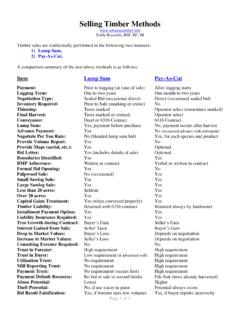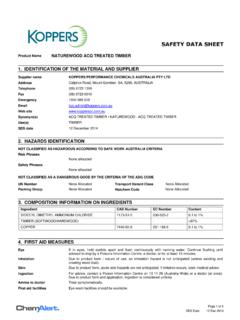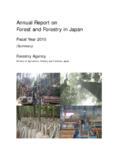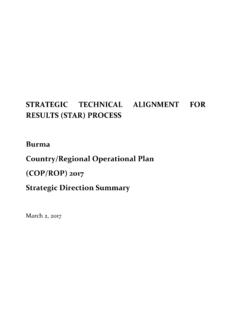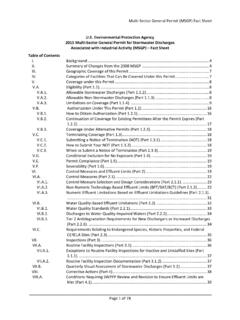Transcription of STRUCTURAL TIMBER (Obtained from Amendment 4 …
1 STRUCTURAL TIMBER Grades and their Characteristic Stresses STRUCTURAL TIMBER ( obtained from Amendment 4 NZS3603:1993). summary Average Minimum Colour Modulus of Modulus of Bending Compression Tension Marks Grade Elasticity Elasticity Strength Strength Strength Amended STRUCTURAL TIMBER grading standards effective on 1 April 2007. (MSG. (Stiffness) (Stiffness) (MPa) (MPa) (MPa). Only). (GPa) (GPa). The amended standards introduce a new suite of grades the new grades are outlined and explained. No 1 Framing (unverified) (Green). All but one new grade requires verification of STRUCTURAL properties an No 1 Framing explanation of the verification process is given. (unverified). Grade availability Not all grades and sizes may be available an MSG6 explanation on why some sizes and grades may not be available is G8 (Green) provided.
2 VSG8 TIMBER designers, builders and end users must specify and use grades MSG8 Black correctly key aspects are explained. VSG10 Amended Standards Cited In The B1 Compliance Document To The MSG10 Green Building Code MSG12 Purple MSG15 Orange Changes have been made to the way STRUCTURAL TIMBER is graded with the introduction of amendments to New Zealand Standards governing STRUCTURAL TIMBER grades. The Department of Building and Housing has amended Compliance Document B1 Structure Amendment 2 NZS 3604:1999 TIMBER Framed Buildings to the Building Code by referencing the following amended Standards: Amendment 2 NZS 3604 provides design information in the form of tables for three sets of Amendment 4 NZS 3603:1993 TIMBER Structures Standard. grades. Tables are provided for: Amendment 2 NZS 3604:1999 TIMBER Framed Buildings.
3 MoE (Stiffness) 6 grades (MSG6 and Unverified No 1 Framing). Amendment 1 NZS 3622: 2004 Verification of TIMBER Properties. MoE (Stiffness) 8 grades (MSG8,VSG8 and G8 (when dry)). The amended Compliance Document will become effective on 1 April 2007. The amended MoE (Stiffness) grades (this is the value assigned for wetted in service 8 grades). standards will apply to building work consented on or after 1 April 2007. (G8, MSG8, VSG8). MoE (Stiffness) 10 grades (MSG10 and VSG10). Amendment 4 NZS 3603:1993 TIMBER Structures Standard NZS 3622:2004 Veri cation of TIMBER Properties Amendment 4 NZS 3603 introduces the following new grades: All of the new grades (except unverified No 1 Framing grade) require verification in Visually Stress Graded (VSG) 8 & 10. accordance with the verification Standard NZS 3622:2004. The verification method and pass Machine Stress Graded (MSG) 6,8,10,12,15.
4 Criteria are the same for both grading systems (VSG & MSG). The requirement to use a third party quality assurance audit organisation is mandatory. G8 grade (this is a green version of a dry VSG/MSG8 grade where the TIMBER is verified in its green or non dried condition). Unverified No1 Framing: This grade is visually graded to the No 1 Frame specifications VSG And MSG Grades in NZS 3631:1988 but its STRUCTURAL properties are not verified. Because this grade Both grading systems assign TIMBER into grades according to their stiffness and strength. is not verified, its STRUCTURAL properties have been reduced from its previously established values. A machine stress grader is only capable of testing the stiffness of TIMBER but not strength. There is correlation between stiffness and strength but visual characteristics such as knots are the main determinant of strength.
5 Machine Stress Graded (MSG) TIMBER is subject to visual grading ( visual override') in accordance with AS/NZS 1748 after it has been graded for stiffness although larger defects are allowed compared to VSG grades which must be graded to the No 1 Frame grade specifications of NZS 3631:1988. In order to determine whether the strength properties for machine stress graded product Outdoor STRUCTURAL Grades are being achieved, samples of the production must be taken and tested on a separate static testing machine in accordance with the verification Standard NZS 3622:2004. The Where TIMBER is used in a situation where it may be wetted in service ( it will not remain verification process is also important to check that the machine stress grader is assigning dry throughout its design life) the green condition stresses and moduli values for the grade the correct stiffness values for the grade.
6 Shall be used. NZS3603:1993 defines TIMBER as being green at 25% moisture content and dry at 16% moisture content with a tolerance up to a maximum of 18%. NZS3604:1999. Quality Assurance Static Testing Machine used for Verifying TIMBER section outlines a number of situations where TIMBER can be wetted in service and also provides design tables based around the green condition stresses and moduli values. Force applied to TIMBER Bearers and joists for decks are an example of members that may be wetted in service. NZS3603 only provides green condition stress values for VSG grades and not MSG grades. However, the wetted in service tables within NZS3604 include MSG grades alongside their VSG equivalents. It appears that when NZS3603 was amended the Standards committee did not anticipate MSG grades would be used in wet service situations.
7 It should be noted that the durability requirements of NZS3602:3003 must be met when TIMBER is used in a wet service situation. G8 Grade G8 graded TIMBER is a verified visual grade which has been verified green to the green condition stresses and moduli values determined for equivalent dry MoE 8 grades VSG8 and MSG8. The G8 grade was provided to cater for producers of outdoor treated ( ) TIMBER as often these timbers are not dried below 25% moisture content prior to treatment and will remain wet post treatment. Typically this grade of TIMBER will be used in a wet service situation because it has been treated to hazard class However, if dry, it may also be used as an equivalent to VSG8 and MSG8. Similarly, VSG8 and MSG8 are equivalent to G8. when in the green condition and can be used in the same wet service situations as long as Dial gauge measures de ection Test span Force indicator linked to a they are treated to the appropriate hazard class.
8 Load cell measures force How the Veri cation Process Works VSG (Visual Stress Grades) are sorted on the basis of visual characteristics. Visual characteristics are good for determining strength but not so good for predicting stiffness. The verification process described in NZS 3622:2004 is an output control system, which Whereas the quality assurance checking for machine stress grades is probably more means that TIMBER is continuously taken from production and tested for stiffness and strength. important for ensuring the strength characteristics are achieved, in the case of visual stress The verification Standard is based on random sampling and statistical analysis to ensure the grades, the verification process is more pertinent for checking the stiffness characteristics. population of TIMBER within a stress grade is meeting the requirements of the grade.
9 The key aspect to ensure both grading systems are compliant is the verification process and TIMBER that has been randomly selected from production is tested on a static bending test both grading systems are subject to the same rules and grade acceptance criteria set out in machine (the same type of machine is used for both MSG and VSG systems). A test for the verification Standard NZS 3622:2004. stiffness and bending strength is performed on each sample and the results are analysed and plotted against the acceptance criteria for the grade. There was no provision made for a VSG6 grade when the standards were designed as the rationale was that unverified No 1 Framing grade had the properties of MSG6 and therefore The new verified grades in NZS 3603:1993 have an assigned modulus of elasticity (MoE). a VSG6 grade was not required.
10 Some producers who have recognised the importance of (stiffness) and a lower bound MoE. verification and are choosing to verify the properties of No 1 Framing and marking it as Verified No 1 Framing. This grade is essentially a VSG6 grade but by marking it as Verified For example VSG8 and MSG8 have an MoE of GPa and a lower bound MoE of GPa. No 1 Framing it technically complies with the standards as there is no mention of a grade For TIMBER to be assigned into these grades it must maintain a characteristic average MoE of called VSG6. GPa and a lower 5th percentile MoE of GPa. In the case of the lower 5th percentile, the statistical power estimates that 95% of the product will exceed the minimum value with 75% confidence. Essentially, each grade has an average and minimum MoE. The key aspect to ensure both grading systems For strength properties, the values assigned are based on the same principle as the lower 5th percentile MoE, in that they are an estimate of the property value determined with 75%.

